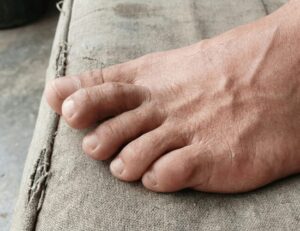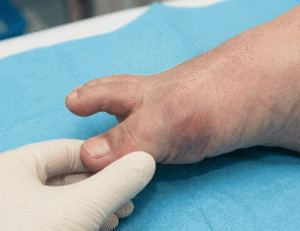
Fix Overlapping Toes: Conservative & Surgical Treatment Solutions
Overlapping Toes: What You Need to Know The architecture of the human foot is remarkable, 26 bones, 33 joints, and over 100 muscles, tendons, and

As we age, our bodies evolve and our feet often feel the burden first. They’ve carried us for decades, after all. At South Florida Multispecialty Medical Group, we’ve seen how preventive foot care can protect mobility, independence, and even prevent more serious health conditions.
For seniors, foot issues don’t just cause discomfort; they can impact balance, limit movement, and lead to infections or serious complications, especially for those with diabetes or circulatory issues. That’s why understanding how to care for older feet isn’t just important, it’s essential.
With age, skin loses elasticity, muscles weaken, and joints may stiffen. Blood circulation becomes less efficient, especially in the lower extremities. Combine these natural changes with years of wear and tear, and it’s easy to see how feet become more susceptible to a variety of conditions.
Here are a few common changes we observe in our elderly patients:
The protective layer that cushions our soles begins to wear down, making walking less comfortable. Thinner skin also makes feet more prone to cuts, bruises, and ulcers.
Reduced circulation slows down wound healing. That’s especially concerning for diabetics, as even minor injuries can become serious infections if not addressed quickly.
Osteoarthritis in the feet can lead to stiffness, swelling, and pain, affecting gait and balance. Bunions, hammertoes, and other deformities can worsen without proper foot support.
We often see older adults walk into our hospital with long-ignored problems. These are the most frequently diagnosed foot issues in seniors:
Corns and Calluses are often caused by years of friction from poorly fitted shoes, they can be painful and become infected if improperly treated.
Moisture buildup and reduced hygiene flexibility can lead to athlete’s foot or fungal toenails. Both are treatable, but best diagnosed early.
Ingrown toenails are more than just uncomfortable, they can cause infections that spread, especially in those with lowered immune response.
Years of pressure on the heel can inflame the plantar fascia ligament, causing sharp pain with each step.
Left untreated, ulcers can develop into deeper infections, sometimes requiring hospitalization or even amputation.
Loss of sensation affects balance and leads to undetected injuries. We frequently recommend foot exams for elderly patients with diabetes or peripheral arterial disease.
The good news: simple daily habits can delay or even prevent most foot-related issues. At SFL Medical Group, we work closely with caregivers and families to incorporate these practices into daily routines.
Clean feet daily with warm water and mild soap. Dry thoroughly especially between your toes to prevent fungal growth.
Apply a gentle moisturizer to the tops and bottoms of your feet. Avoid the area between your toes, as it can harbor excess moisture and bacteria.
Look for blisters, cuts, or color changes. If eyesight is limited, use a mirror or ask a family member for help.
Avoid rounding or digging into nail edges to prevent ingrown nails. Use clean tools or let a podiatrist trim hard-to-reach nails safely.
Shoes should have a wide toe box, non-slip soles, and adequate arch support. As we age, our shoe size can change, get measured regularly.
Elevating feet during rest supports circulation and helps minimize swelling.
Not every change indicates a crisis, but the following symptoms need urgent medical attention:
We always tell our patients: when in doubt, bring it up. Early diagnosis means fewer complications and better outcomes.
Family involvement makes a huge difference. If you’re caring for an aging loved one, here’s how you can help:
Many seniors wait too long before seeing a specialist. Be the voice that advocates for preventive care instead of crisis management.
If you notice reduced mobility, limping, or reluctance to walk, those may point to foot discomfort.
Long-handled sponges, foot mirrors, and non-slip bathmats can make foot hygiene safer and easier.
If you or a loved one needs help navigating foot health, contact our team at SFL Medical Group. We’re here to walk with you every step of the way.
More To Explore

Overlapping Toes: What You Need to Know The architecture of the human foot is remarkable, 26 bones, 33 joints, and over 100 muscles, tendons, and

Dislocating your big toe may not sound like a serious injury until it happens. At SFL Medical Group, we’ve seen firsthand how even a seemingly

©2025 South Florida Multispecialty Medical Group. All Rights Reserved.